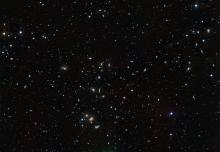Listen to today's episode of StarDate on the web the same day it airs in high-quality streaming audio without any extra ads or announcements. Choose a $8 one-month pass, or listen every day for a year for just $30.
You are here
Messier 13
Globular star clusters are like skyscrapers in the suburbs. They’re densely populated structures surrounded by a lot of open space. Most of them are well outside the Milky Way’s disk. They’re tight balls of hundreds of thousands of stars, so they’re easy to spot.
An example is Messier 13, in the constellation Hercules. It climbs into view in the northeast by 9 or 10 p.m. Under dark skies, it looks like a faint smudge of light. Binoculars enhance the view.
M13 is about 25,000 light-years away. It contains several hundred thousand stars, packed into a ball about 150 light-years across. Most of its stars are right in the middle. They’re packed more than a hundred times tighter than the stars in our own galactic neighborhood. As a result, many more bright stars would speckle the skies of any planets in that region.
Most of those stars would look faint, and yellow or orange. That’s because M13’s original big, bright, blue stars have long since expired. The survivors are less massive than the Sun, and a good bit older. Such stars look redder and fainter than the Sun. A few stars have passed beyond the prime of life, so they’ve puffed up and gotten extremely bright. They’ll soon lose their outer layers, though, leaving only their hot but dead cores, known as white dwarfs.
A few stars in M13 have merged. That’s made them hotter, brighter, and bluer — the stand-out residents of a galactic skyscraper.
Script by Damond Benningfield



